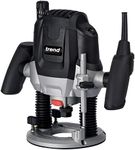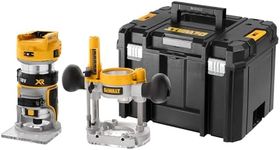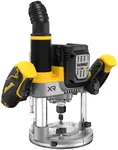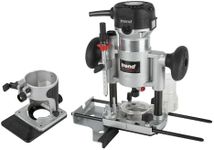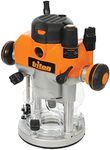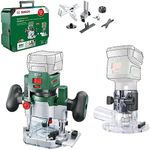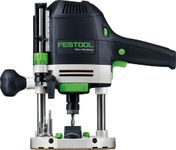Buying Guide for the Best Plunge Routers
Choosing the right plunge router can significantly impact the quality and efficiency of your woodworking projects. Plunge routers are versatile tools that allow you to start cutting in the middle of a workpiece, making them ideal for tasks like creating grooves, dadoes, and intricate designs. When selecting a plunge router, consider the key specifications that will affect its performance and suitability for your needs.PowerPower in plunge routers is measured in horsepower (HP) or amps, and it determines how effectively the router can cut through different materials. Higher power means the router can handle tougher materials and larger bits without bogging down. For light-duty tasks or softwoods, a router with lower power (around 1.25 HP or 6-8 amps) may suffice. For more demanding tasks or hardwoods, consider a router with higher power (2 HP or more, 10-15 amps) to ensure smooth operation.
Speed ControlSpeed control refers to the ability to adjust the RPM (revolutions per minute) of the router bit. This is important because different materials and bit sizes require different speeds for optimal cutting. Variable speed routers allow you to tailor the speed to your specific task, which can improve the quality of the cut and extend the life of the bit. If you work with a variety of materials, a router with variable speed control is beneficial. For single-material use, a fixed speed may be adequate.
Plunge DepthPlunge depth is the maximum depth the router can cut into the material. This is crucial for tasks that require precise depth settings, such as mortising or inlay work. Routers with greater plunge depth offer more versatility and can handle a wider range of projects. If your work involves deep cuts or varied depths, look for a router with a larger plunge capacity. For shallow or consistent depth work, a smaller plunge depth may be sufficient.
Base TypeThe base type of a plunge router affects its stability and ease of use. Common base types include fixed and plunge bases. Plunge bases allow for vertical movement, making them ideal for starting cuts in the middle of a workpiece. Fixed bases are more stable and suitable for edge work. If your projects require intricate interior cuts, a plunge base is essential. For edge routing or simpler tasks, a fixed base might be more appropriate.
Collet SizeCollet size determines the diameter of the router bits you can use. Common sizes are 1/4 inch and 1/2 inch. Larger collets (1/2 inch) can accommodate bigger bits, which are useful for heavy-duty tasks and provide more stability. Smaller collets (1/4 inch) are suitable for lighter tasks and finer details. If your work involves heavy-duty routing, opt for a router with a 1/2 inch collet. For detailed or light work, a 1/4 inch collet may be more suitable.
ErgonomicsErgonomics refers to the design and comfort of the router during use. A well-designed router will have comfortable grips, easy-to-reach controls, and balanced weight distribution, reducing fatigue during extended use. Consider how the router feels in your hands and whether the controls are intuitive. If you plan to use the router for long periods, prioritize ergonomics to ensure comfort and ease of use.

